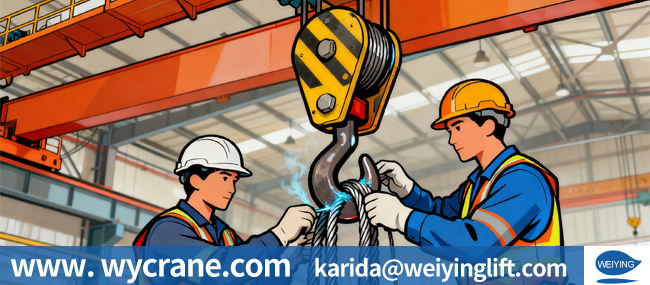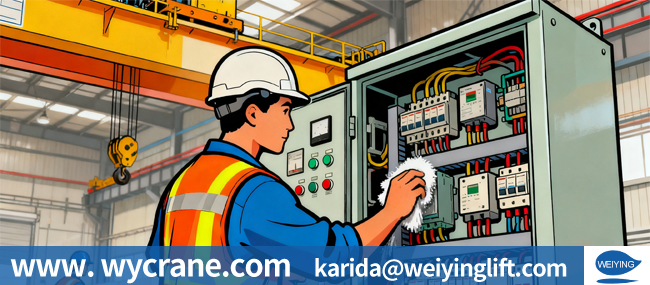Bridge cranes are vital pieces of equipment in industrial production, logistics, and construction. To ensure safe operation, high efficiency, and long service life, it is essential to carry out regular maintenance and inspections. Proper maintenance not only reduces downtime and repair costs but also minimizes safety risks. The maintenance of bridge cranes can be divided into three main categories: daily maintenance, periodic maintenance, and annual maintenance, supplemented by general care and operation tips.

Daily maintenance focuses on visual checks and functional tests before and after operation. These inspections help detect early signs of wear, damage, or malfunction.
Check the hook and latch carefully for any cracks, deformation, or excessive wear. Make sure the latch operates smoothly and locks securely. A damaged or malfunctioning latch may cause the load to slip off, leading to serious accidents.
Test all operating controls, including hoisting, lowering, trolley movement, and bridge travel, to ensure they function properly. Verify that the braking system responds promptly and reliably. Any delay or slippage in braking may indicate worn brake linings or hydraulic issues that require attention.
Inspect the wire rope for broken wires, kinks, flattening, or excessive wear. Damaged wire ropes significantly reduce lifting safety. Replace the rope immediately if the number of broken wires exceeds the allowable limit or if corrosion and deformation are observed.
Perform a visual inspection of the crane’s main structure, including beams, joints, and fasteners. Check for cracks, rust, loose bolts, or deformation. Even small structural defects may develop into major safety hazards if ignored.
Ensure that all safety devices are functioning properly, including the hook safety latch and limit switches. Remove any loose objects from the crane to prevent them from falling during operation.

Periodic maintenance should be performed weekly, monthly, or quarterly, depending on usage frequency and working conditions. The goal is to preserve mechanical performance, electrical reliability, and structural soundness.
Proper lubrication is essential for reducing friction and preventing premature wear. Regularly lubricate gears, bearings, shafts, and wire ropes according to the manufacturer’s recommendations. Use the specified lubricants to avoid chemical incompatibility or viscosity problems.
Inspect the crane’s beams, girders, and joints for signs of deformation, corrosion, or fatigue cracks. Tighten or replace any loose or broken bolts and rivets. If severe corrosion is found, clean the surface and reapply protective coatings to prevent further deterioration.
Examine the tracks (or rails) for wear, alignment, and cleanliness. Dirt, debris, or uneven surfaces can lead to vibration and misalignment during operation. Check crane wheels for flat spots, cracks, or uneven wear, and replace them if necessary.
Test the entire electrical system, including control panels, limit switches, contactors, and wiring insulation. Verify that emergency stop buttons and overload protection devices are fully operational. Faulty electrical systems can cause unexpected movements or shutdowns.
Inspect the paint and coating conditions regularly, especially in outdoor or coastal environments where humidity and salt can accelerate corrosion. Repaint and reinforce protective coatings as needed to prolong the lifespan of the crane’s metal components.
Annual maintenance involves a more comprehensive inspection and testing process to verify the overall condition of the crane and ensure compliance with safety regulations.
Perform a load test at least once a year to confirm that the crane can safely lift and handle its rated load capacity. The test should be supervised by qualified personnel using certified weights and proper safety measures. The results should be documented and filed for future reference.
Arrange a full professional inspection by certified technicians or third-party agencies. This inspection includes structural analysis, mechanical testing, and electrical evaluation. The purpose is to ensure that the bridge crane meets all national and international safety standards, including ISO and CE requirements. Recommendations from the inspection report should be implemented promptly to correct any detected issues.
In addition to regular maintenance schedules, following good operational habits can significantly extend the service life of the crane and improve workplace safety.
Keep the crane clean and free from dust, grease, and corrosive substances. Accumulated dirt can obscure cracks or cause electrical short circuits. Cleaning also allows better visual inspection during routine checks.
If any defect or abnormality is detected, stop operation immediately. Do not attempt to continue using the crane until the problem has been properly diagnosed and repaired by qualified personnel. Neglecting small defects often leads to severe failures and costly downtime.
Always refer to the manufacturer’s manual for specific maintenance procedures, lubrication intervals, and suitable lubricants. Using the wrong lubricants or maintenance methods can result in mechanical damage and void warranties.
Maintain a detailed maintenance log, including dates, inspection results, parts replaced, and corrective actions taken. Proper documentation helps track the crane’s condition over time and provides valuable data for performance analysis and audits.
Regular maintenance is not merely a routine task—it is an essential safety requirement and a cost-effective practice. By following daily, periodic, and annual maintenance procedures, operators can ensure that the bridge crane remains in optimal condition, operates safely, and delivers consistent performance. Investing in preventive maintenance significantly reduces unexpected breakdowns, enhances operational efficiency, and extends the overall lifespan of the equipment.
With 34 years of manufacturing experience and 12 years of export expertise, we have built a dual advantage of professional qualifications and a global presence. Our business covers more than 100 countries and regions across Asia, Europe, the Americas, Africa, and Oceania. We are certified under the ISO management system and hold CE product certifications. Our main product lines include six major series—electric hoists, electric winches, gantry cranes, bridge cranes, marine cranes, and portal cranes—comprising nearly 100 different models.
If you want to learn more, please contact us.
E-mail address: karida@weiyinglift.com
Website: www.wycrane.com